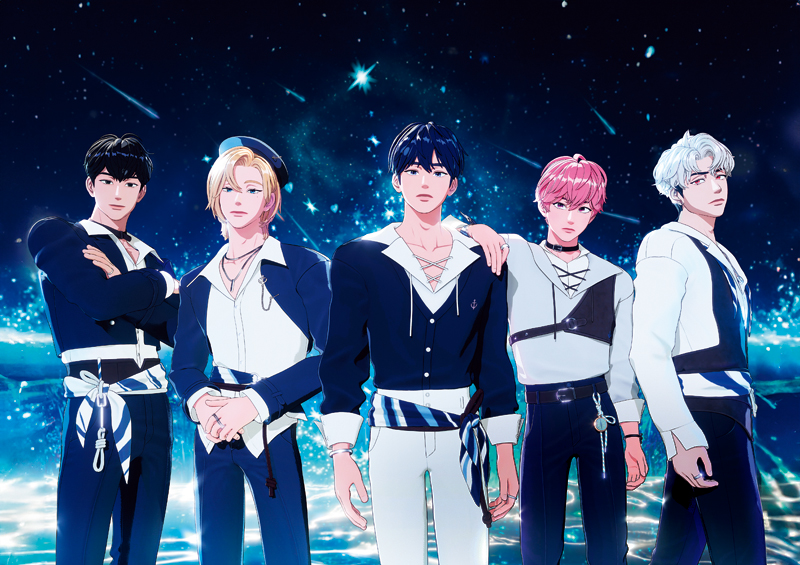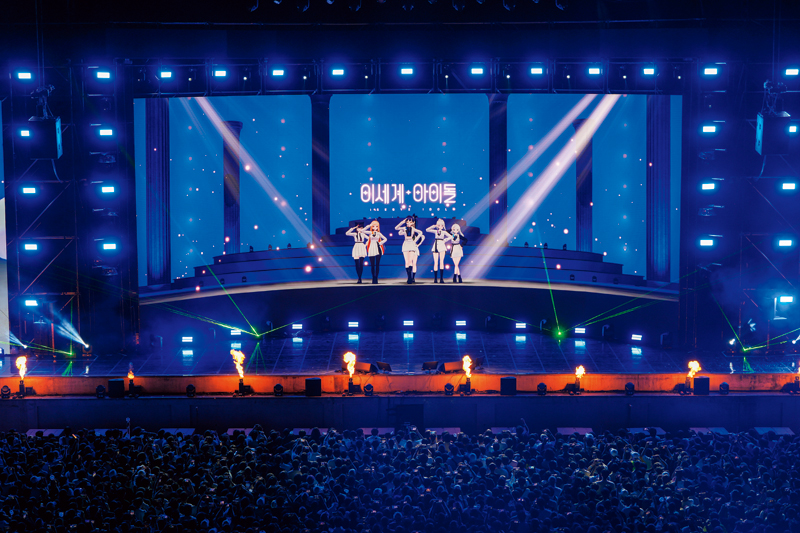Virtual K-pop idol singers are increasingly shaping mainstream culture, solidifying their presence in the physical world. Through the application of artificial intelligence, virtual performers are positioned to reach even higher levels of realism and sophistication in their singing, dancing, and engagement with fans.

© VLAST
In February of this year, The Hyundai Seoul, a department store in Yeouido, unveiled a moving waterfall, its largest media art piece to date. Surprisingly, however, visitors showed greater interest in experiencing the rising newcomers in Korean entertainment: virtual idol groups. ISEGYE IDOL, a six-member girl group; PLAVE, a five-member boy band; and StelLive, another six-member girl group, were featured at large pop-up stores.
The next month, PLAVE surpassed popular girl group LE SSERAFIM and singer BIBI to take the number one spot on MBC’s TV program Show! Music Core. It marked the first instance of virtual idols claiming the top spot on a Korean TV music show.
These examples illustrate how virtual entertainment is gradually dismantling established boundaries. With their singing and choreography, virtual entertainers now get the same reaction as their human counterparts. Anyone who still believes that their virtual existence renders their popularity inherently fake might want to think again.

On March 9, 2024, PLAVE made history by becoming the first virtual idol group to claim the No. 1 ranking on a Korean TV music show. To celebrate, PLAVE shared a picture with their fans on social media.
© VLAST
THE SHAPE OF THINGS TO COME
Virtual idols took off during the COVID-19 pandemic. The shutdown of public life prompted entertainment and technology companies to try and fill the vacuum. Virtual idols soon appeared, thanks to audiovisual advancements in artificial intelligence.
Progress in AI continues to push virtual idols deeper into the entertainment sphere. Whereas in the past only faces were used, new technology means that full body images can be d. Real-time face-swapping technology allows singers and dancers to lend their talent to avatars, their virtual counterparts.
The intricacies of computer graphics seem to be an afterthought to fans, who don’t inquire about the identities of the real singers operating behind the scenes. They eagerly embrace virtual artists just as they are, mirroring the fandom and admiration for real idols. This shows that, in 2024, Korean virtual idols have now firmly established their own ecosystem.
The groundbreaking ISEGYE Festival in September 2023 gave a preview of what was to emerge. The milestone music event at Songdo Moonlight Festival Park in Incheon seamlessly intertwined the virtual metaverse and physical reality through music. It showcased sixteen groups, including the virtual girl group ISEGYE IDOL, virtual YouTubers and artists, and real-life performers. The festival attracted around 20,000 visitors to the site, with a seat occupancy rate of over 95% during simultaneous screenings in cinemas sparking widespread excitement and lively conversations.
PLAVE’s achievement was no fluke. The virtual boy group burst onto the scene just a year ago. More than 200,000 copies of the group’s debut album ASTERUM: The Shape of Things to Come were sold in the week after its release. Their second album, ASTERUM: 134-1, did even better and sold nearly 570,000 copies, the most among virtual boy groups and the 17th most among all boy bands.
Another example of overwhelming fan support was seen at the end of 2023. Tumblebug, a popular Korean crowdfunding platform, launched a campaign for the webtoon MAGICAL GIRL ISEGYE IDOL. The fundraising target was 20 million won but within 24 hours, an astounding 2.5 billion won had poured in. By the end of the month-long campaign, the total was nearly 4.2 billion won, a record in the platform’s history.

Performance by ISEGYE IDOL in September 2023 at the ISEGYE Festival, the first music event to seamlessly blend the metaverse with the real world.
© Parable Entertainment
VIRTUAL REALITY IDOLS
When discussing virtual reality, some might remember Adam, a cyber-singer who debuted in 1998 and evoked enthusiastic responses that mirrored the sentiment at the turn of the century. Similarly, æspa, a girl group that debuted in 2020, initially consisted of four real individuals and their corresponding avatars. In 2021, Rozy, a virtual influencer, captivated audiences by using cutting-edge technology that produced strikingly realistic visual features.
Exhibiting significant differences from their virtual human predecessors, the virtual idols of today fall into two broad categories: those based on animation and those embodied in 3D. Past creations relied on representing the actual images, but most of today’s popular virtual idols embody stylized characters.
Animating actual images with graphic techniques requires countless hours. In addition, there is the risk of falling into the “uncanny valley” of producing a negative emotional response to non-human s that bear a striking resemblance to humans.
The three groups showcased at The Hyundai Seoul are also based on characters but highlight different features. ISEGYE IDOL and PLAVE are the most successful examples. While they are often grouped together under the umbrella term of virtual idols, ISEGYE IDOL emphasizes the “virtual” aspect and PLAVE centers on the notion of “idol.”
The members of ISEGYE IDOL are presented as virtual YouTubers, known as “VTubers.” Operating in accordance with established VTuber formulas, the group covers all aspects from group formation and management to public appearances and engagements. Their narrative, originating from their creation through internal competition, exemplifies the new bridge between “virtual” and “idol” that is spreading through the entire music industry.
PLAVE, on the other hand, functions like any other boy group, apart from their characters’ appearances; they release albums, appear on music shows, and participate as guests on radio programs. Moreover, they host video call events for fans and produce live-streaming content to engage with them. These features stem from the fact that PLAVE’s production agency was initially established as a company specializing in virtual characters. That generates unprecedented synergy in blending the appeal of both humans and virtual characters.
FUTURE OF VIRTUAL IDOLS
Future technological advances will render virtual artists even more realistic and eliminate the need for a real person behind the scenes doing the singing and dancing. Virtual idols also have the potential to revolutionize contact with fans. Rapid and intimate communication with their fans is critical to idols’ success. AI allows virtual artists to speak a multitude of languages and remember individual fans and their past conversations. This enables fans around the world to easily forge connections with their favorite virtual idols.
Finally, AI technology also has the benefit of allowing entertainment companies to significantly reduce their costs, as it eliminates the need for years of training and preparation to turn someone into an idol. What’s more, these performers do not cancel gigs or lose revenue because of sickness, scandals, or other personal issues.
No one is suggesting virtual idols will replace humans completely. In fact, many music listeners say they much prefer real people. So, for now, the entertainment industry will likely continue to present real idol groups, virtual idols, and a mixture of both.
Kim Yoon-ha Popular Music Critic